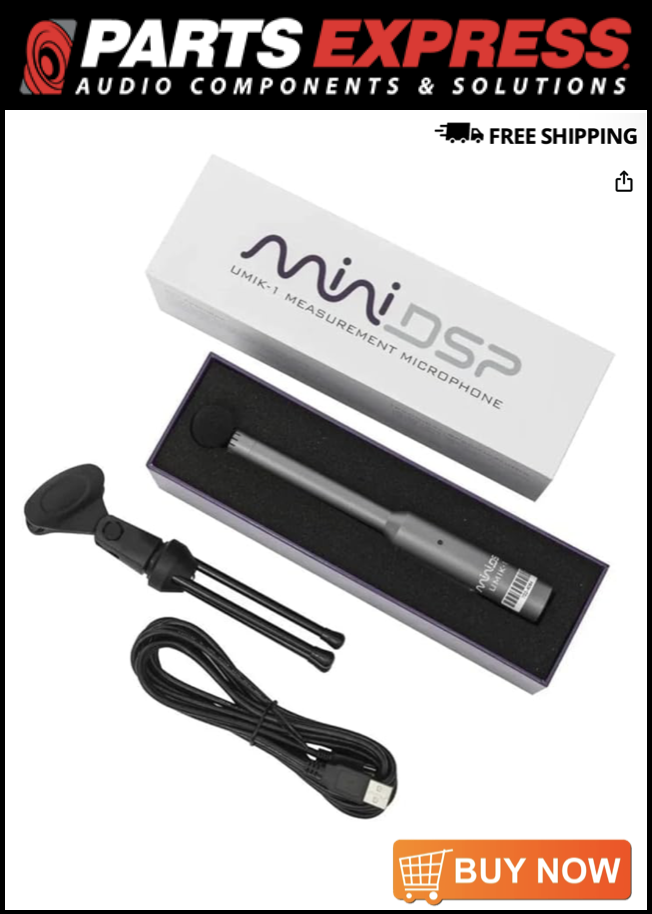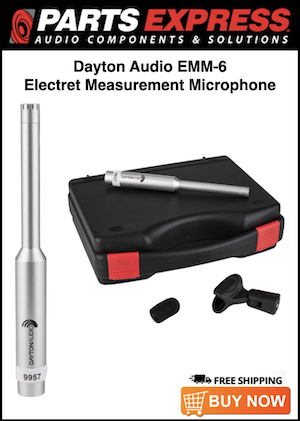Antoine B
New Member
Thread Starter
- Joined
- Jun 26, 2024
- Posts
- 15
Hello, I wanted to follow the guide “How to make quasi-anechoic speaker measurements / spinoramas with REW and VituixCAD” to make measurements of loudspeakers in a hangar. Here is my installation:

I use the UMIK recommended with REW, with standard calibration files found on internet (I took the picture after the measurement, normally all this stuff is wired).
I used a height of 1,75m above the floor, and more distance with all other surfaces except the computer, wires and stools. The microphone is at 1 meter. Calculation gives smallest reflection path at 2*(sqrt(0,5^2 + 1,75^2) = 3,64m, so 2,64m more than direct path, resulting in a time spacing of 2,64/340 = 7,8ms. From what I read it is sufficient to measure the total impulse response of most loudspeakers.
I was expecting a curve like this:

With a first IR followed by quasi silence, then a first reflection and then multiple reflections.
I wasn’t expecting such an ideal curve, however, the first curves I obtained on 2 different loudspeakers seemed to show an impossibility to isolate IR:



The red curve is one “non-conventional” loudspeaker, the two following a more conventional loudspeaker with a remarkable coherence between 2 replicates.
I was wondering if it wasn’t REW fail to reconstruct IR so I tried to measure an IR on Audacity (with logically less SNR):

The result suffers the same issue: there are these slow waves with a frequency of approximately 100Hz after the short decrease after the peak, preventing to isolate the first reflection (and nothing happens at 7,8ms in all cases, zooming on REW curves green and blue indicate 6,4ms and 8,3ms for visible peaks.
Note that before the IR, all curves are quasi flat.
I need help to discriminate between 2 possibilities:
I use the UMIK recommended with REW, with standard calibration files found on internet (I took the picture after the measurement, normally all this stuff is wired).
I used a height of 1,75m above the floor, and more distance with all other surfaces except the computer, wires and stools. The microphone is at 1 meter. Calculation gives smallest reflection path at 2*(sqrt(0,5^2 + 1,75^2) = 3,64m, so 2,64m more than direct path, resulting in a time spacing of 2,64/340 = 7,8ms. From what I read it is sufficient to measure the total impulse response of most loudspeakers.
I was expecting a curve like this:
With a first IR followed by quasi silence, then a first reflection and then multiple reflections.
I wasn’t expecting such an ideal curve, however, the first curves I obtained on 2 different loudspeakers seemed to show an impossibility to isolate IR:
The red curve is one “non-conventional” loudspeaker, the two following a more conventional loudspeaker with a remarkable coherence between 2 replicates.
I was wondering if it wasn’t REW fail to reconstruct IR so I tried to measure an IR on Audacity (with logically less SNR):
The result suffers the same issue: there are these slow waves with a frequency of approximately 100Hz after the short decrease after the peak, preventing to isolate the first reflection (and nothing happens at 7,8ms in all cases, zooming on REW curves green and blue indicate 6,4ms and 8,3ms for visible peaks.
Note that before the IR, all curves are quasi flat.
I need help to discriminate between 2 possibilities:
- These curves are exploitable if I use a window of say 5-6 ms after peak, there is simply something unusual in the IR of these loudspeakers.
- These curves aren’t exploitable due to a problem in the experiment (my hypothesis is that the stools might be too big to not interfere with the measurement) and would be clean with experiment fixing
What do you think about that?














